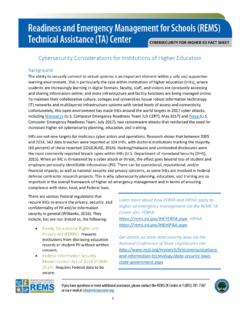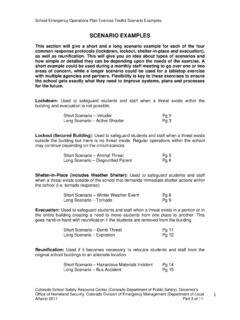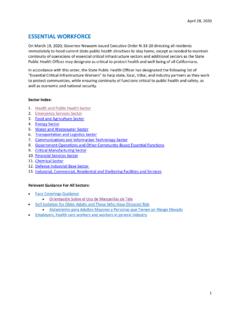Transcription of Emergency Response and Crisis Management (ERCM) …
1 Department of EducationVolume 2, Issue 8 Emergency Response and Crisis Management (ERCM) Technical Assistance CenterTo ensure the safety of students, faculty and staff, schools and school districts nationwide should create comprehensive, multi-hazard Emergency Management plans that focus on the four phases of Emergency Management prevention-mitigation, preparedness, Response and recovery. All-inclusive plans and well-executed processes will ensure the continuity of school and school districts daily business operations in the face of natural and man-made disasters, criminal activity on campuses and outbreaks of infectious diseases. Schools must prepare for the expected to be prepared for the unexpected, asserts Robert Laird, director of school safety at the Mississippi Department of schools and school districts have established Emergency Management plans; however, they are often not comprehensive, practiced regularly or written in collaboration with the local community.
2 It is highly recommended that schools and school districts adopt a comprehensive, multi-hazard approach to Emergency Management and work to ensure that their plans take into account the unique needs of the school, any procedures and processes already in place that could be improved and the benefits of adding structure to identified gaps. Creating Plans Based on the Four Phases of Emergency ManagementThe four phases of Emergency Management help to establish a firm foundation for successful planning. The phases are all interconnected; therefore, proactive efforts in each phase impact the quality of the outcomes of the other three phases. The most effective plans provide direction and support to the entire school community and are continuously reviewed and enhanced through routine activities to build a school or school district s capacity to prevent and mitigate emergencies, prepare for incidents and respond to and recover from following suggestions, categorized by the four phases of Emergency Management , will assist schools and school districts in establishing or refining their Emergency Management plans.
3 Phase 1: Prevention-Mitigation The prevention-mitigation phase is designed to assess and address the safety, security and integrity of school buildings, learning environments and students and staff. Prevention is the action or actions taken by schools and CREATING Emergency Management PLANSThe Safe and Drug-Free Schools and Communities Act (SDFSCA) requires local education agencies (LEAs) receiving SDFSCA funds to have a plan for keeping their schools safe and drug-free that includes: appropriate and effective discipline policies; security procedures; prevention activities; a student code of conduct; and an Emergency Management plan for responding to violent or traumatic incidents on school grounds. school districts to decrease the likelihood that an Emergency will occur. Mitigation is the action or actions taken to eliminate or reduce risks, damages, injuries or deaths that may occur during an Emergency , such as a natural disaster or chemical spill.
4 Examples of prevention activities that may be incorporated into a school s Emergency Management plan may include: Establishing communication procedures for staff, parents, students and the media; Enforcing policies related to food preparation, mail handling, building access and student accountability; andConducting comprehensive, strength-based vulnerability assessments of school buildings and grounds, school cultures and climates, staff skills, and community resources to help Crisis Response teams identify, analyze and profile hazards and develop appropriate policies and activities may include: Fencing hazardous areas;Anchoring outdoor equipment that could become flying projectiles; and Bolting bookshelves to walls and securing loose wires. Phase 2: Preparedness The preparedness phase readies schools and school districts to respond in a rapid, coordinated and effective manner to an Emergency .
5 Examples of preparedness activities that may be incorporated into a school s Emergency Management plan include:Identifying weaknesses in the current Emergency Management plan ; Interpreting the data collected from the vulnerability assessments conducted during the prevention-mitigation phase; developing or updating appropriate processes and procedures (based on the identification of weaknesses as well as the data from the vulnerability assessments) to ensure the safety of students, faculty, staff and visitors; Creating and strengthening relationships with community partners, including members of law enforcement, fire safety, local government, public health and mental health agencies and the media;Delegating roles and responsibilities, including levels of authority; Establishing an Incident Command System (ICS); Implementing functional training exercises for faculty and staff with first responders; Implementing evacuation, lock-down and shelter-in-place drills; andCoordinating Emergency Management plans with those of state and local agencies to avoid unnecessary duplication.
6 Phase 3: ResponseWhen emergencies arise, schools and school districts must quickly implement the policies and procedures developed in the prevention- mitigation and preparedness phases to effectively manage the Crisis and protect the school community. Throughout the Response phase, efforts focus on deescalating the Emergency and taking accelerated steps toward recovery. Examples of Response activities include:Delegating responsibilities;Deploying resources; Activating the communication, accountability and decisionmaking procedures outlined in the predetermined Emergency Management plan ; Documenting all actions, decisions and events ( , what happened, what worked and what did not work);Holding debriefing meetings; and Reviewing after-action reports to determine recovery activities and necessary revisions to the Emergency Management plan based on lessons learned.
7 Phase 4: RecoveryThe recovery phase quickly restores educational and business operations in schools and school districts following an incident. Recovery is an ongoing process that includes not only the mental, emotional and physical healing process of students, faculty and staff, but a school s physical (buildings and grounds), fiscal (daily business operations) and academic (a return to classroom learning) recuperation. Strong partnerships with members of the law enforcement and public and mental health communities are essential for effective recovery efforts. Examples of recovery activities include:Outlining service delivery systems;Providing mental health services or offering referral services; developing letter templates for emergencies;Predetermining strategies for accepting donations following a death or an incident; Establishing a policy for standing or temporary memorials and ensuring that it is consistent for all events;Ensuring that a process is in place for soliciting and receiving parental consent for such activities as providing medical treatment or receiving counseling services;Establishing a process for screening and registering volunteers; andDeveloping and practicing a Continuity of Operations plan (COOP) at the school and school district levels.
8 Establishing Crisis Response Teams The process of developing and maintaining an Emergency Management plan is complex; therefore, before a plan is developed, district Crisis Response teams and individual Crisis Response teams should be assembled. These teams are composed of a variety of professionals with expertise in Emergency Management ( , police, fire and Emergency medical services personnel) and include community partners ( , public and mental health professionals) and school-based staff ( , facilities and cafeteria managers, nurses, disability specialists, counselors, teachers and administrators). Partner agreements, or memoranda of understanding, should be created by the school and school district Crisis Response teams to clearly delineate team members roles and Response teams are typically responsible for: Establishing relationships with community partners;Coordinating vulnerability assessments; developing training activities and conducting exercises to support and improve the Emergency Management plan ; Establishing and enforcing a school and school district s Emergency Management plans; andGuiding and supporting the development of individual schools Crisis Response teams.
9 developing a Multi-Hazard Emergency Management PlanSchool and school district Crisis Response teams should incorporate the following steps to ensure the development of comprehensive, multi-hazard Emergency Management plans. Align Plans and Procedures School and school district Crisis Response teams should collaborate with local, state, regional and federal agencies (before a Crisis occurs) to integrate processes and determine what resources may be shared. As an incident escalates, well-aligned Response procedures will facilitate a smooth transfer of command, ensure the effective activation of additional resources, and promote clear communication among responders, Crisis Response teams and members of the local community. The National Incident Management System The Department of Homeland Security (DHS) manages the National Incident Management System (NIMS), a unified national system for managing domestic incidents.
10 The NIMS, made up of six components Command and Management ; Preparedness; Resource Management ; Communications and Information Management ; Supporting Technologies; and Ongoing Management and Maintenance specifies the standardized methods all Emergency responders should follow to plan , coordinate and carry out responses to a variety of incidents. It also allows schools and local agencies to jointly manage incidents. The NIMS Integration Center (NIC), available at , offers guidance and resources to schools and school districts nationwide on all phases of Emergency Management planning. Federal Emergency Management Agency The Federal Emergency Management Agency (FEMA) also supports local collaboration, steers state preparedness efforts and provides guidance and resources to schools and school districts on managing incidents. FEMA s Web site, , offers information in English and in Spanish to assist individuals in preparing and planning for emergencies.














